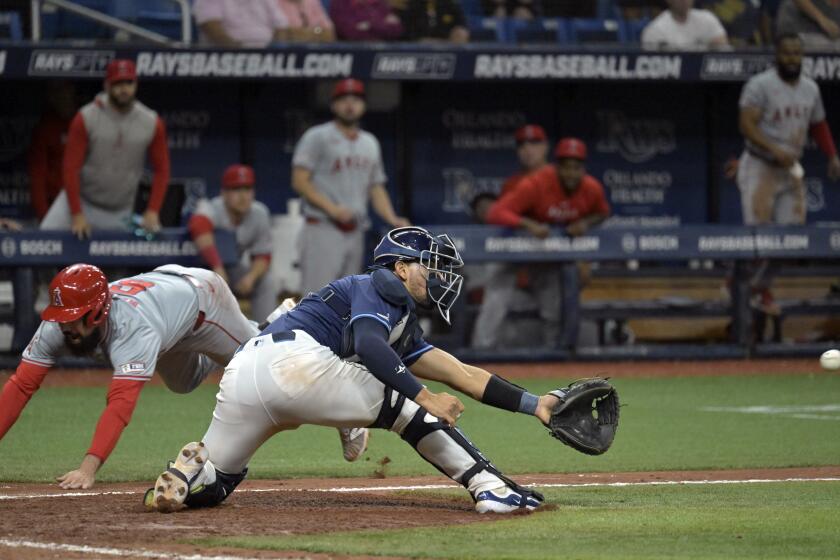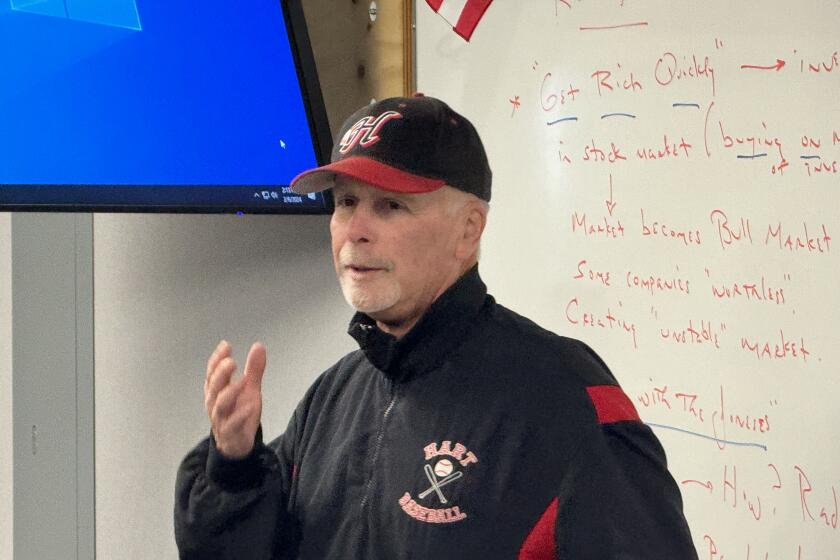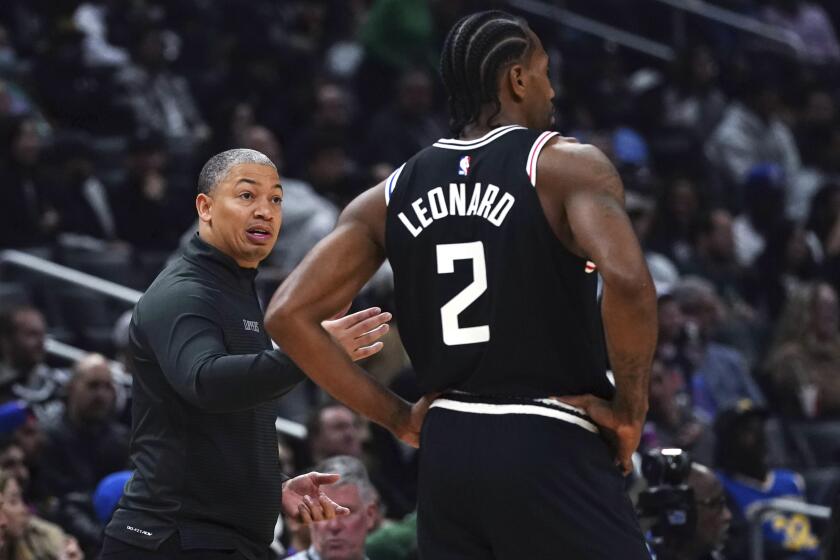Column: Gloves in NFL have gained popularity but use is largely unregulated

How does Odell Beckham Jr., left, make a one-handed catch? Gloves, like those sported by Rams running back Todd Gurley, top right, and a teammate, bottom right, certainly help.
Odell Beckham Jr. was a rookie when he leaped, a superstar when he landed.
The New York Giants receiver made one of the signature plays of the 2014 NFL season with his 43-yard touchdown catch against Dallas, jumping and bending his body Matrix-style, then somehow securing the football with just three fingers.
In the aftermath of what some people called the most athletic catch in league history, Beckham acknowledged he had a small assist on the play — the red-and-white XXL Nike Vapor Jet 3.0 gloves he was wearing. But he wasn’t the only one to give some love to the gloves.
“You have to be careful about the way you analyze that play because you don’t want people calling you a hater or whatever,” said Tim Brown, a Hall of Fame receiver. “But you can’t make that play without those kind of gloves. It’s just impossible.
“The guy’s a freak of nature, no doubt about it, I’ll give you that. He has the big hands and all that. But those gloves are so ‘tackified’ these days that that’s part of the reason you see guys making those kinds of catches.”
Said former NFL receiver Cris Collinsworth, now color analyst on NBC’s “Sunday Night Football”: “I think if they took the gloves completely away from the guys, including the quarterbacks at this point, it would have a major impact on what the game looked like on the field. And not for the better.”
While the topic of slightly deflated footballs has sparked countless debates in recent months, the growing popularity of gloves that almost adhere to the ball has largely gone unnoticed — and unregulated.
“No one looks at those gloves,” John Madden said. “I saw them when I was at a meeting in Indy. They passed them around and somebody made the comment that, ‘Pretty soon, these gloves are going to be able to catch a ball without a hand in them.’”
Atlanta Falcons President Rich McKay, chairman of the league’s competition committee, said the group has talked extensively in recent years about whether the NFL should come up with new regulations for gloves. Although no decisions are imminent, he said, it’s a subject expected to come up again.
Various companies make the gloves — Nike, Adidas, Under Armour and Cutters among them — and the products have similar qualities, namely special surfaces (sometimes leather, sometimes rubber) on the palms, fingers and thumbs that allow a lock-down grip on the ball.
“I think it’s time to go back and look at the gloves and see if, with what’s going on here with sports science in the past 10 years, if there isn’t too much of an advantage being gained,” McKay said.
Gloves essentially have become part of the uniform, even forming the team logo when positioning the palms together. It isn’t just receivers who are wearing gloves these days. Virtually everyone wears them, including quarterbacks.
“You know something’s up when guys like Tom Brady and Kurt Warner and Peyton Manning are wearing gloves to throw a football,” former NFL quarterback Rich Gannon said. “You’re starting to go, ‘Wait a second here…’ Guys for years dreaded bad weather, cold weather, and they didn’t want to have anything that would take their hands off the football. Now guys are like, ‘These gloves are better than the human skin.’”
But not everyone whose job depends on hanging on to the football thinks the cutting-edge gloves provide an unfair advantage.
“You don’t catch the ball with your hands, you catch it with your eyes,” Philadelphia tight end Zach Ertz said. “So to say that anybody can go out there and catch a football with a million guys running around, it’s different.”
Coby Fleener, tight end for the Indianapolis Colts, said there are pros and cons to the gloves, which he began to wear at Stanford, where he was a teammate of Ertz.
“There are some aspects where they really help you, but some aspects where they hinder you,” he said. “To be able to feel the ball when it hits your hands, it makes it more difficult when the gloves are on. I wear them as much for blocking as I do for receiving, because it gives you that extra layer of protection.”
NFL players used to slather their hands with Stickum, a gooey adhesive that also came in a spray form, reasoning that would give them a better grip on the ball. That substance was outlawed in 1981.
Soon after, some players — receivers, mostly — began trying different types of gloves. The styles ranged from thin leather versions not unlike the ones golfers wear, to neoprene scuba gloves, which kept hands warm but took away any feel of the football.
Quarterback Doug Flutie, who spent part of his career in Canada, used rubberized glass-cutter gloves, which were ill-fitting by today’s standards but gave him a grip in all weather conditions.
By the mid-1980s, Neumann began selling gloves with “tackified” fingers and palms that gained wide popularity. Some barehanded quarterbacks said those transferred a slight residue onto the ball that was actually beneficial.
“I remember playing catch with guys who would wear them,” Gannon said. “The ball would come back and it would be kind of easier to throw.”
The NFL made changes to address that. The league’s uniform code says that “adhesive or slippery substances on the body, equipment, or uniform of any player” are prohibited. Tackified gloves are allowed, though, provided “such tacky substance does not adhere to the football or otherwise cause handling problems for players.”
Although the NFL doesn’t have more specific standards for gloves, such regulations do exist and were developed by governing bodies of high school and college football. The Sports & Fitness Industry Assn. oversees the third-party testing of gloves to make sure the products meet but do not exceed specifications for adhesiveness and other qualities.
Some gloves are personalized, with a player’s name or number stitched in. The look is important too. Arizona Cardinals cornerback Patrick Peterson, for instance, has multiple pairs with eye-catching designs in black, white, red, gold and orange fatigue versions.
“I’m a big fashion guy,” Peterson said. “I love to match.”
While Peterson goes through a pair of gloves per game, other players use two and sometimes three pairs in the same game.
“We’ve heard from equipment managers that guys will try a pair on and say, ‘It just didn’t feel right, so I had to get a different one,’” said Gary Bethea, general manager of Cutters and Team Sports. “But then the equipment guy will just repackage that pair and bring it out another time and it will be fine.”
Ted Walsh, who was the assistant equipment manager for the San Francisco 49ers for 18 years, remembers receiver Jerry Rice using gloves when they first began gaining popularity. He liked to wear his so skintight that the palms would frequently tear during games when the football smacked them.
“Jerry was bare hand, bare hand, then he started trying gloves,” recalled Walsh, now visiting clubhouse manager for the Seattle Mariners. “But if he would drop a ball in a game, off would come the gloves.”
Denver’s Manning wears gloves on occasion, usually for cold-weather games, but he also appreciates the beauty of going without.
“I like Dallas Clark,” he said of his former star tight end in Indianapolis. “He used to go natural; commando if you will. There’s something to that. Look, I think a guy can catch or he can’t, gloves or no gloves. So true hands catchers can catch no matter what.”
The difference now, Madden said, is receivers can confidently go up for a ball with one hand and inconspicuously bend the rules with the other hand.
“I’ve been watching preseason games and I see this,” he said. “When you can catch the ball with one hand, or even start to catch the ball with one hand, that frees up your other hand to push off. You can get real subtle about that.”
Collinsworth said the use of gloves has forever changed the game.
“Before these gloves, I’d never seen anybody make an overhand catch — when their fingers point toward the ground — below the waist, but now I see guys make those catches below the knees,” he said.
“They’re brilliant catches, and brilliant players, I don’t want to take anything away from them. But if you played before gloves, you had to slide or dive to make that catch. Maybe somebody could make the ball stick in their hands like that, but I had never seen it.”
Collinsworth, in the broadcast booth for Beckham’s catch, rubbed his eyes in disbelief at that incredible play.
“Odell Beckham is probably in another class; he’s got Spider-Man hands,” he said. “But some of the catches you see now would be different catches. Not that they wouldn’t make them, but they would be different kinds of catches.”
Then again …
“Every Sunday we say, ‘Oh, my goodness! Look at that!’” Collinsworth said. “That’s a good thing. It’s an entertainment business. Why not make it as entertaining as possible?”
Twitter: @LATimesfarmer
MORE FROM SAM FARMER:
Tyrann Mathieu isn’t letting down the Arizona Cardinals
The rookie is a veteran: Aspiring Ram Daniel Rodriguez is battle tested
More to Read
Get our high school sports newsletter
Prep Rally is devoted to the SoCal high school sports experience, bringing you scores, stories and a behind-the-scenes look at what makes prep sports so popular.
You may occasionally receive promotional content from the Los Angeles Times.







